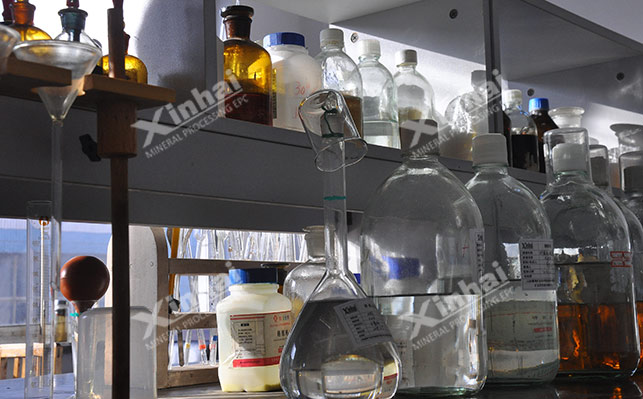
15311826613
Click to add WeChatIn the process of lithium mica beneficiation, flotation agents play a vital role. Suitable agents can improve the recovery rate and concentrate grade of lithium mica, thereby improving the efficiency and economic benefits of mineral processing. Common lithium mica flotation ( lepidolite flotation)agents mainly include collectors, regulators and inhibitors. The following will introduce the functions and characteristics of various agents in detail.
In the lepidolite beneficiation process, flotation agents play a vital role. Suitable agents can improve the recovery rate and concentrate grade of lepidolite, thereby improving the beneficiation efficiency and economic benefits. Common lepidolite flotation agents mainly include collectors, regulators and inhibitors. The following will introduce the functions and characteristics of various agents in detail.
Collectors are used to selectively adsorb on the surface of the target mineral during the flotation process, making it hydrophobic and attached to bubbles, thereby separating minerals from gangue. In the flotation process of lithium mica, commonly used collectors are cationic amines and fatty acids.

Under acidic conditions, cationic amine collectors have a good collection effect on lithium mica. Its mechanism of action is mainly to bind to the surface of lithium mica through electrostatic adsorption and chemical bonding. The surface of lithium mica usually carries a negative charge, and cationic amine collectors will dissociate positively charged ions in aqueous solution. These cations will electrostatically attract the negative charge on the surface of lithium mica, thereby adsorbing on the surface of lithium mica. In addition, the nitrogen atoms in the amine molecules have lone pairs of electrons, which can form chemical bonds with the metal ions on the surface of lithium mica, further enhancing the binding force between the collector and lithium mica. In this way, the surface of lithium mica is made hydrophobic, and it can attach to the bubbles and float to the surface of the pulp with the bubbles to achieve the flotation of lithium mica.
Fatty acid collectors are suitable for different pH conditions, and mainly achieve the collection effect by chemically reacting with the metal ions on the surface of lithium mica. Oleic acid molecules contain carboxyl groups, and the oxygen atoms in the carboxyl groups have strong electronegativity, which can react chemically with the metal ions on the surface of lithium mica to form hydrophobic fatty acid salts. These fatty acid salts cover the surface of lithium mica, making its surface hydrophobic, so that they can attach to bubbles and achieve the flotation of lithium mica.
The adjuster is mainly used to adjust the pH value of the pulp and the properties of the mineral surface, thereby improving the selectivity and efficiency of the flotation process. In the flotation process of lepidolite, sulfuric acid is a commonly used adjuster.

As an adjuster, sulfuric acid is mainly used to adjust the pH value of the pulp to an acidic range of 2-4. Under acidic conditions, on the one hand, it is conducive to the adsorption of cationic amine collectors. When cationic amine collectors are used in acidic solutions, they can better dissociate positively charged ions, thereby enhancing the electrostatic attraction with negative charges on the surface of lepidolite and improving the collection effect. On the other hand, the acidic environment can also change the properties of the mineral surface, inhibit the floatability of some gangue minerals, and improve the selectivity of lepidolite flotation.
Sulfuric acid is a strong acidic substance with strong acid adjustment ability, which can quickly and effectively adjust the pH value of the pulp to the required range. However, sulfuric acid is highly corrosive, and safety protection should be paid attention to during use to avoid damage to equipment and operators.
The function of the inhibitor is to inhibit the floating of gangue minerals, improve the flotation selectivity of lepidolite, and enable lepidolite to be separated from gangue minerals more effectively. In the lepidolite flotation process, commonly used inhibitors are water glass and lignin sulfonate.

Water glass is a common inorganic inhibitor, and its main component is sodium silicate. In the ore pulp, water glass will hydrolyze to form silicate ions and silicate colloids. These silicate ions and silicate colloids can be adsorbed on the surface of gangue minerals such as quartz to form a hydrophilic film, thereby preventing the adsorption of collectors on the surface of gangue minerals, reducing the floatability of gangue minerals, and enabling lepidolite to float preferentially.
Lignin sulfonate is a natural high molecular organic compound that can be adsorbed on the surface of gangue minerals to prevent the adsorption of collectors. Lignin sulfonate molecules contain a large number of hydrophilic groups, which can complex or adsorb with metal ions on the surface of gangue minerals to form a hydrophilic protective film, making the surface of gangue minerals hydrophilic and difficult to attach to bubbles, thereby achieving an inhibitory effect on gangue minerals.
The above are the types of reagents commonly used in lepidolite flotation. Different types of lepidolite flotation reagents play different roles in the mineral processing process and each has unique characteristics. In practical applications, it is necessary to reasonably select and use these reagents according to the properties of lepidolite ore, the requirements of mineral processing technology and the performance characteristics of the reagents to achieve efficient flotation of lepidolite and comprehensive utilization of resources.